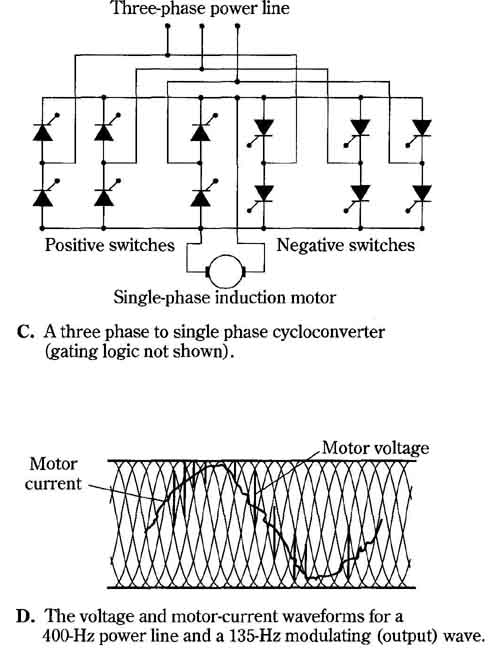AMAZON multi-meters discounts AMAZON oscilloscope discounts
In bringing to a close this investigation of electronic controls for electric motors, it’s appropriate to discuss some trends likely to assume increasing importance. Rather than speculate over the possibilities of applying the magnetic monopole or harnessing gravitational force, we prefer to deal with the devices, techniques, and systems that are presently realizable.
Pulse-width modulation systems for ac motors
This variable-frequency technique fabricates quasi-sine waves from weighted pulses of constant amplitude. The waveshapes depicted in FIG. 24 are relevant. Because of the filtering or integrating action of the motor inductance, the motor current is a satisfactory approximation of sine wave. One method of producing pulse-width modulation is to deliver properly timed gate trigger pulses to an SCR circuit such as that shown in FIG. 25. This is somewhat easier than might initially be expected. Ordinarily, the gate control of an SCR is lost once triggering has occurred. However, in this circuit a pair of SCRs, such as Q1 and Q2, operate like an SPDT toggle-switch.
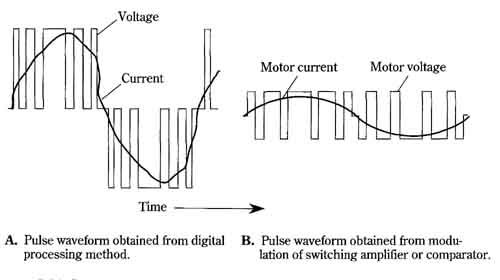
FIG. 24 Pulse-width modulated voltage and smoothed motor-current waveform.
[A. Pulse waveform obtained from digital processing method. B. Pulse
waveform obtained from modulation of switching amplifier or comparator.]
Assume that Q1 is in its on state. Then, by triggering Q2 to its on state, Q1 is automatically commutated to its off state by the polarity of the induced voltage across L1. Similarly, anytime Q1 is triggered on, conduction in Q2 is extinguished due to L2. The same relationships exist with regard to Q3 and Q4. The truth table for this behavior is shown in FIG. 26. The sequential triggering pulses required to produce the pulse-width-modulated waveform can be generated by various digital logic systems, and can include programmable ROMs, multiplexers, and even microprocessors.
Pulse-width modulation can also be produced by linear/digital arrangements. For example, the method shown in FIG. 27 makes use of two LM111 comparator ICs. These are connected to be self-oscillating, thereby providing a “carrier” frequency. A lower-frequency sine wave impressed at the input of the arrangement results in a pulse-modulated output wave, such as the one illustrated in FIG. 24B. Power can be boosted by means of bipolar-transistor output stages.
The cycloconverter
The cyclo-conversion principle provides another means of efficiently varying the frequency of the power applied to an ac motor. A cycloconverter circuit is shown in FIG. 28A. The equivalent circuit in FIG. 28B is useful in analyzing the operation of cycloconverters. Two frequencies are applied to the system. One of these in which is often obtained from the ac power line. Frequency f1 can be considered a “carrier” modulated by the second frequency, f2. The output frequency is also at f2 and does not appear to have a waveshape desirable for motor operation. However, the inductive reactance of ac motors is sufficient to convert the current wave into a fairly good sinusoid. This is particularly true when operation is from a three-phase line. A simplified schematic diagram of a three-phase to a single-phase cycloconverter is shown in Fig. 2-28C. The motor waveforms corresponding to a frequency-reduction ratio of three are illustrated in FIG. 28D. The ratio of line frequency to modulation frequency can be as low as two in polyphase systems—below that, serious deterioration of the output wave takes place. There is no high limit to the frequency-reduction ratio, however. Indeed, the cycloconverter performance improves because the output wave is then fabricated from a large number of small elements.
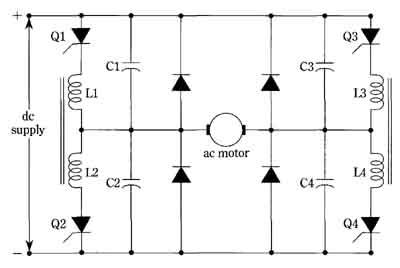
FIG. 25 Simplified schematic of the thyristor pulse-width modulator.
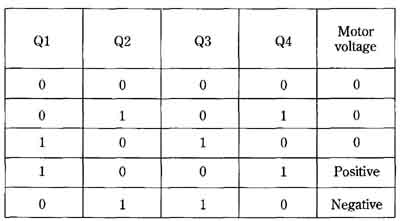
FIG. 26 Truth table for pulse-width modulator shown in FIG. 25.
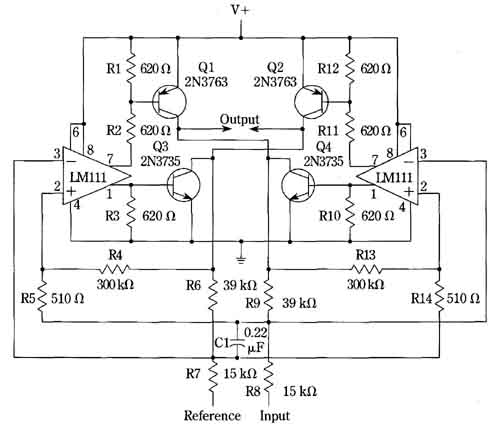
FIG. 27 Integrated-circuit system for producing pulse-width modulated
waves.
A. A single phase to single phase cycloconverter.
B. Equivalent circuit to (A).
C. A three phase to single phase cycloconverter (gating logic not shown). Single-phase induction motor / Positive switches; Negative switches
D. The voltage and motor-current waveforms for a 400-Hz power line and a 135-Hz modulating (output) wave.
With the cycloconverter, an induction motor can be operated from zero speed to one-third, and in some cases one-half, the speed that would otherwise be obtained from the power-line frequency. In addition to providing efficient and continuous speed control, the cycloconverter enables an induction motor to develop maximum torque at slow speeds. It’s fortunate that induction motors develop maximum torque at a certain slip speed, regardless of the actual speed of the rotor. Thus, if maximum torque corresponds to a slip speed of 50 RPM when the rotor is turning at 1740 RPM, the maximum torque is available when the rotor turns at a much slower speed. This is achieved when the stator is fed with a frequency that makes the difference between the rotating magnetic field and the rotor speed equal to 50 RPM. The significance of this is that the induction motor can be caused to simulate the powerful tractional effort of the dc series motor, but with out its commutation problems and maintenance. Therefore, even though the cycloconverter technique has been known for a long time, don’t be surprised to find that it has been rediscovered for use in electric vehicles.
SCRs with gate turn-off capability
It’s obvious that a more ideal control device would result from an appropriate combination of thyristor and transistor characteristics. In particular, it would be very useful to have available an SCR or triac that could be gated off as well as on. The semiconductor manufacturers have been working toward this objective for a long time. The General Electric silicon-controlled switch, the Motorola gate-control switch, and the RCA GTO device are examples of SCRs capable of turn-off by the gate signal alone in an ac or dc circuit. Some of these devices can handle power levels much higher than usual “signal-level” thyristors. At present, they are beginning to see application in switching-type power supplies, electronic ignition systems, and in controls for fractional-horsepower motors.
Figure 29A illustrates an RCA GTO controlled rectifier with 50 watts allowable dissipation. Figure 29B and C show two turn-off techniques for the RCA GTO thyristor. Both circuits provide the required—70 volts to the gate when switch Si is closed. Whereas the circuit of FIG. 29B requires operation from a 70-volt power supply, the addition of the inductor in FIG. 29C makes possible the use of a 35-volt power supply. Of course, an auxiliary 70-volt power supply can also be employed for turn-off. Turn-on is initiated by a positive pulse, as iii a conventional SCR. Switch Si can be a transistor, a thyristor, or other switching device. The family of devices exemplified by FIG. 29 can handle a nominal steady current of 15 amperes and can block up to 600 volts. Present development is aimed at 200-ampere, 1000-volt units. When such ratings are attained, the relevancy to motor-control applications can hardly be overestimated.
Motors designed for a wide range of control
For the most part, the electronic control techniques described in sections 4 and 5 work reasonably well with off-the-shelf motors. However, the majority of these motors were not originally intended for wide ranges of control and might suffer in efficiency when operated at very low and very high speeds. This adversely affects other performance parameters such as torque, speed regulation, and acceleration, causing increased burden to be placed on the electronic control and drive systems. If these motors were designed to keep pace with the new control techniques, smoother and more reliable operation would result. Because solid-state technology is more flexible than motor technology, there will probably always be somewhat of a lag between the two. However, it’s now widely realized that motors must be made with lower eddy current and hysteresis losses; with ability to withstand high acceleration, rapid braking, and abrupt reversal—and with superior insulation.

FIG. 29 The RCA GTO silicon-controlled rectifier. A. Symbol and appearance
of device. Gate (pin 1), (pin 2) Anode, Gate, Cathode; (Flange) B. Gate
turn-off technique using a 70-volt power supply. C. Gate turn-off technique
using a 35-volt power supply.
Optimization of motor characteristics will result in extended specialization; servo motors will have low rational inertia, traction motors will exert high torque at low speeds and frequencies, precision synchronous motors will emphasize minimum instantaneous deviation from average synchronous speed, etc. Brushless dc motors appear destined for more widespread application. These motors will probably operate according to a scheme similar to that described for the experimental brushless motor in this section. However, it’s likely that Hall-effect sensors, rather than opto electronics, will be employed. And the internal electronics will involve not only ICs but power transistors or thyristors as well. Such a motor will successfully compete with fractional-horsepower commutator-type machines. In principle, the technique is applicable to larger integral-horsepower motors, but the ac induction motor then looms as a formidable rival.
Because feedback systems will become increasingly popular, there will be a wider selection of useful packages, such as motors with built-in tachometers and en coders. Also, printed circuit motors and the newer hollow-rotor types will, because of their capabilities for high acceleration, team up increasingly with the new electronic control techniques.
Smart motor controls
Sophisticated control of electric motors, now in its beginning stages, will revolutionize industrial processes. Such control will incorporate computers and microprocessors, and will implement the popular concept of “automation.” For example, motors that drive machine tools to produce three-dimensional contouring of metal will carry out their assigned tasks according to the directives stored in programmed memories. Moreover, many such “smart” motors will perform together. Allowances will be made for the individual and momentary cutting and milling requirements of each motorized “machinist,” and all of the contoured objects will emerge identically shaped within close tolerances. The social and economic implications of such motor control are obviously great. Surely, a technology capable of multiplying material goods can help realize the universal quest for the better life. Its attainment simply requires the proper programming format.

